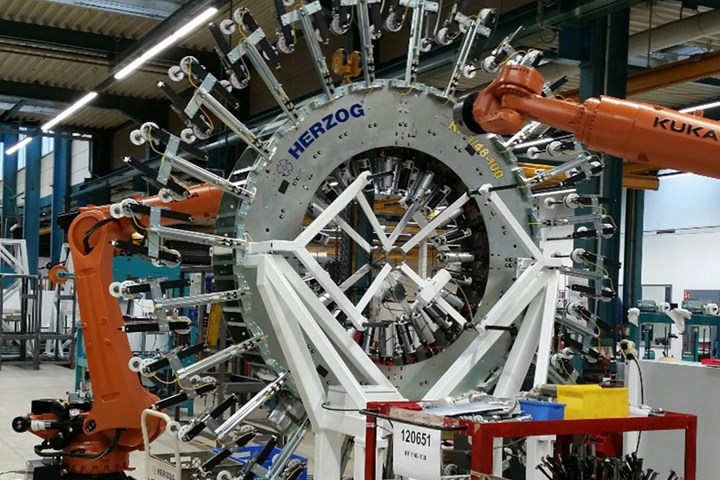Collins Aerospace invests in braiding technology, secures funding for next-gen components
The multi-axis composite braider will be used to prove out production for complex-shaped components like pressure vessels, battery enclosures and more.
Share

Collins Aerospace (Cedar Rapids, Iowa, U.S.) announced in February 2021 that it is investing in a new multi-axis composite braider for its Banbury, U.K. facility, to support the manufacture of next-generation continuous fiber-reinforced components with complex shapes, with a focus on system simplification, weight reduction and cost competitiveness.
More recently, to aid in this effort, Collins formed a U.K.-based collaboration of four companies, which includes Collins, Composite Integration (Saltash, Cornwall, U.K.), Crompton Mouldings (Elland, U.K.) and Bitrez (Standish, U.K.). Partners have been awarded a four-year, $3.6 million grant to develop these complex composite components in alignment with the U.K.’s Aerospace Technology Institute’s (ATI) innovation strategy, Accelerating Ambition. Collins’ work will be conducted at its Actuation Systems facility in Banbury, U.K., via the new braider and resin transfer molding (RTM) equipment.
According to Collins, the braider will enable the company to deliver integrated, functional and complex components at a more competitive price to challenge conventional materials. Potential markets are said to include automotive and green energy as well as aerospace, and Collins says applications currently in development include integrated transmission shafts, complex-shaped fuel pipes, Type IV and V pressure vessels and eVTOL battery enclosures. The team will also be developing integrated composite component technology for future commercial aircraft that will feature composite wings rather than metallic.
Collins says the installed and commissioned braider has been integrated with an automated press and high-speed RTM equipment, enabling the application of snap cure resins. This automated development cell will be used to prove out production and demonstrate rapid cycle times. In addition to this cell, Collins’ dedicated development facility also includes a robotic filament winder, tailored fiber placement (TFP) machine, various assembly rigs and CNC machines.
“Not only are new technologies needed to support next-gen aircraft, but also new processes that enable high-volume manufacturing using increased levels of automation,” says Ed Dryden, vice president of Actuation Systems for Collins Aerospace. “We appreciate ATI’s support as we pursue these new technologies.”
Related Content
-
Noble Gas Systems 350-bar conformable pressure vessels pass HGV2 standard tests
Conformable tanks with new materials pass technical tests for hydrogen storage, to compete with Type IV pressure vessels using CFRP.
-
Co-molding SMC with braided glass fiber demonstrates truck bed potential
Prepreg co-molding compound by IDI Composites International and A&P Technology enables new geometries and levels of strength and resiliency for automotive, mobility.
-
Corebon, Composite Braiding partner to enhance TPC manufacturing
Collaboration aims to overcome production limitations with tubular thermoplastic composites (TPC) by using induction-heated tooling and high-quality commingled braids.

.jpg;width=70;height=70;mode=crop)














